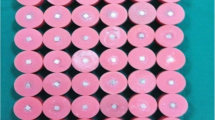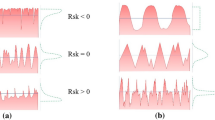Abstract
The purpose of this study was to investigate the surface morphology and roughness of zirconia after different surface treatments. Eighty sintered zirconia specimens were divided into four groups (n = 20) according to the surface treatments received: no treatment, erbium:yttrium-aluminum-garnet (Er:YAG) laser irradiation (400 mJ, 10 Hz, 4 W, 100 MPS, distance: 1 mm), tribochemical silica coating with 30 μm aluminum oxide (Al2O3) modified by silica, and air abrasion with 110 μm Al2O3 particles. After the surface treatments, the surface roughness (Ra in μm) of the specimens was evaluated using a surface texture measuring instrument. Surface morphology of a specimen from each group was evaluated with atomic force microscope (AFM) and scanning electron microscope (SEM) analyses. The surface roughness values were statistically analyzed by the Kruskal-Wallis and Mann-Whitney U tests (p = 0.05). All of the surface treatments produced rougher surfaces than the control group (p < 0.005). While there were no significant differences between the surface roughness of laser and silica groups (p > 0.05). SEM and AFM analyses revealed changes in surface topography after surface treatments, especially in the laser group with the formation of rare pits and in the silica and air abrasion groups with the formation of microretentive grooves. According to the results of the statistical and microscopic analyses, all of the surface treatments can be used for roughening zirconia prior to cementation; however, air abrasion is the most effective surface treatment to obtain micromechanical retention.



Similar content being viewed by others
References
Yoshida K, Yamashita M, Atsuta M (2004) Zirconate coupling agent for bonding resin luting cement to pure zirconium. Am J Dent 17:249–252
Wolfart M, Lehmann F, Wolfart S, Kern M (2007) Durability of the resin bond strength to zirconia ceramic after using different surface conditioning methods. Dent Mater 23:45–50. doi:10.1016/j.dental.2005.11.040
Denry I, Kelly JR (2008) State of the art of zirconia for dental applications. Dent Mater 24:299–307. doi:10.1016/j.dental.2007.05.007
Kern M, Wegner SM (1998) Bonding to zirconia ceramic: adhesion methods and their durability. Dent Mater 14:64–71. doi:10.1016/S0109-5641(98)00011-6
Raigrodski AJ (2004) Contemporary materials and technologies for all-ceramic fixed partial dentures: a review of the literature. J Prosthet Dent 92:557–562. doi:10.1016/j.prosdent.2004.09.015
Tinschert J, Natt G, Hassenpflug S, Spiekermann H (2004) Status of current CAD/CAM technology in dental medicine. Int J Comput Dent 7:25–45
Ernst CP, Cohnen U, Stender E, Willershausen B (2005) In vitro retentive strength of zirconium oxide ceramic crowns using different luting agents. J Prosthet Dent 93:551–558. doi:10.1016/j.prosdent.2005.04.011
Luthardt RG, Holzhüter M, Sandkuhl O, Herold V, Schnapp JD, Kuhlisch E, Walter M (2002) Reliability and properties of ground Y-TZP-zirconia ceramics. J Dent Res 81:487–491. doi:10.1177/154405910208100711
Ozcan M, Kerkdijk S, Valandro LF (2008) Comparison of resin cement adhesion to Y-TZP ceramic following manufacturers’ instructions of the cements only. Clin Oral Investig 12:279–282. doi:10.1007/s00784-007-0151-y
Blatz MB, Sadan A, Kern M (2003) Resin-ceramic bonding: a review of the literature. J Prosthet Dent 89:268–274. doi:10.1067/mpr.2003.50
Senyilmaz DP, Palin WM, Shortall AC, Burke FJ (2007) The effect of surface preparation and luting agent on bond strength to a zirconium-based ceramic. Oper Dent 32:623–630. doi:10.2341/07-14
Atsu SS, Kilicarslan MA, Kucukesmen HC, Aka PS (2006) Effect of zirconium- oxide ceramic surface treatments on the bond strength to adhesive resin. J Prosthet Dent 95:430–436. doi:10.1016/j.prosdent.2006.03.016
Bottino MA, Valandro LF, Scotti R, Buso L (2005) Effect of surface treatments on the resin bond to zirconium-based ceramic. Int J Prosthodont 18:60–65. doi:10.1016/j.prosdent.2005.05.011
Della Bona A, Borba M, Benetti P, Cecchetti D (2007) Effect of surface treatments on the bond strength of a zirconia-reinforced ceramic to composite resin. Braz Oral Res 21:10–15
Oyagüe RC, Monticelli F, Toledano M, Osorio E, Ferrari M, Osorio R (2009) Effect of water aging on microtensile bond strength of dual-cured resin cements to pre-treated sintered zirconium-oxide ceramics. Dent Mater 25:392–399. doi:10.1016/j.dental.2008.09.002
de Oyagüe RC, Monticelli F, Toledano M, Osorio E, Ferrari M, Osorio R (2009) Influence of surface treatments and resin cement selection on bonding to densely sintered zirconium oxide ceramic. Dent Mater 25:172–179
Uo M, Sjögren G, Sundh A, Goto M, Watari F, Bergman M (2006) Effect of surface condition of dental zirconia ceramic (Denzir) on bonding. Dent Mater J 25:626–631. doi:10.4012/dmj.25.626
Nishigawa G, Maruo Y, Irie M, Oka M, Yoshihara K, Minagi S, Nagaoka N, Yoshida Y, Suzuki K (2008) Ultrasonic cleaning of silica-coated zirconia influences bond strength between zirconia and resin luting material. Dent Mater J 27:842–848. doi:10.4012/dmj.27.842
Gökçe B, Ozpinar B, Dündar M, Cömlekoglu E, Sen BH, Güngör MA (2007) Bond strengths of all ceramics: acid vs laser etching. Oper Dent 32:173–178. doi:10.2341/06-52
Cavalcanti AN, Pilecki P, Foxton RM, Watson TF, Oliveira MT, Gianinni M, Marchi GM (2009) Evaluation of the surface roughness and morphologic features of Y-TZP ceramics after different surface treatments. Photomed Laser Surg 27:473–479. doi:10.1089/pho.2008.2293
Shiu P, De Souza-Zaroni WC, Eduardo Cde P, Youssef MN (2007) Effect of feldspathic ceramic surface treatments on bond strength to resin cement. Photomed Laser Surg 25:291–296. doi:10.1089/pho.2007.2018
Whitehead SA, Shearer AC, Watts DC, Wilson NH (1995) Comparison of methods for measuring surface roughness of ceramic. J Oral Rehabil 22:421–427. doi:10.1111/j.1365-2842.1995.tb00795.x
Kumbuloglu O, Lassila L, User A, Vallittu PK (2006) Bonding of resin composite luting cements to zirconium oxide by two air-particle abrasion methods. Oper Dent 31:248–255. doi:10.2341/05-22
Burke FJ, Fleimng GJ, Nathanson D, Marquis PM (2002) Are adhesive technologies needed to support ceramics? An assessment of the current evidence. J Adhes Dent 4:7–22
Thompson JY, Rapp MM, Parker AJ (1998) Microscopic and energy dispersive x-ray analysis of surface adaptation of dental cements to dental ceramic surfaces. J Prosthet Dent 79:378–383. doi:10.1016/S0022-3913(98)70148-9
van As G (2004) Erbium lasers in dentistry. Dent Clin North Am 48:1017–1059
Coluzzi DJ (2004) Fundamentals of dental lasers: science and instruments. Dent Clin North Am 48:751–770. doi:10.1016/j.cden.2004.05.003
Sato H, Yamada K, Pezzotti G, Nawa M, Ban S (2008) Mechanical properties of dental zirconia ceramics changed with sandblasting and heat treatment. Dent Mater J 27:408–414. doi:10.4012/dmj.27.408
Curtis AR, Wright AJ, Fleming GJ (2006) The influence of surface modification techniques on the performance of a Y-TZP dental ceramic. J Dent 34:195–206. doi:10.1016/j.jdent.2005.06.006
Kosmac T, Oblak C, Jevnikar P, Funduk N, Marion L (2000) Strength and reliability of surface treated Y-TZP dental ceramics. J Biomed Mater Res 53:304–313
Kosmac T, Oblak C, Jevnikar P, Funduk N, Marion L (1999) The effect of surface grinding and sandblasting on flexural strength and reliability of Y-TZP zirconia ceramic. Dent Mater 15:426–433. doi:10.1016/S0109-5641(99)00070-6
Guazzato M, Quach L, Albakry M, Swain MV (2005) Influence of surface and heat treatments on the flexural strength of Y-TZP dental ceramic. J Dent 33:9–18. doi:10.1016/j.jdent.2004.07.001
Qeblawi DM, Muñoz CA, Brewer JD, Monaco EA Jr (2010) The effect of zirconia surface treatment on flexural strength and shear bond strength to a resin cement. J Prosthet Dent 103:210–220. doi:10.1016/S0022-3913(10)60033-9
Tanaka R, Fujishima A, Shibata Y, Manabe A, Miyazaki T (2008) Cooperation of phosphate monomer and silica modification on zirconia. J Dent Res 87:666–670. doi:10.1177/154405910808700705
Darvell BW (2000) Materials science for dentistry. CRC Pres, Hong Kong
Ozcan M, Vallittu PK (2003) Effect of surface conditioning methods on the bond strength of luting cements to ceramic. Dent Mater 19:725–731. doi:10.1016/S0109-5641(03)00019-8
May LG, Passos SP, Capelli DB, Ozcan M, Bottino MA, Valandro LF (2010) Effect of silica coating combined to a MDP-based primer on the resin bond to Y-TZP ceramic. J Biomed Mater Res B Appl Biomater 95:69–74. doi:10.1002/jbm.b.31684
Acknowledgement
The authors thank Bilal Teymur (Tubitak Marmara Research Center, Gebze) for polishing the specimens; Professor Aslıhan Üşümez (Department of Prosthodontics, Faculty of Dentistry, Gaziantep University) for the supply of the Er:YAG laser unit; Dr.Özgür Duygulu (Tubitak Marmara Research Center, Gebze) for the AFM analysis; Dr. İhsan Akşit (Erciyes University Technology Research and Application Center, Kayseri) for the SEM analysis; and Assistant Professor Mustafa Semiz (Department of Statistics, Selcuk University) for the statistical analysis.
Author information
Authors and Affiliations
Corresponding author
Rights and permissions
About this article
Cite this article
Subaşı, M.G., İnan, Ö. Evaluation of the topographical surface changes and roughness of zirconia after different surface treatments. Lasers Med Sci 27, 735–742 (2012). https://doi.org/10.1007/s10103-011-0965-3
Received:
Accepted:
Published:
Issue Date:
DOI: https://doi.org/10.1007/s10103-011-0965-3




